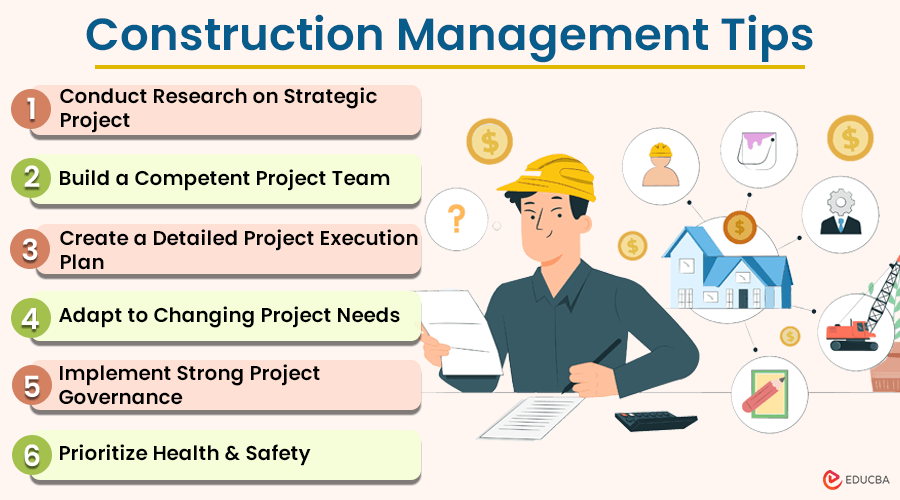
What are Construction Management Tips?
Construction management involves planning, organizing, and supervising a construction project from beginning to end. It involves managing resources like materials, labor, and equipment and ensuring that the project stays on schedule, within budget, and meets quality and safety standards. Construction managers work with architects, engineers, and contractors to make sure that everything runs smoothly and efficiently. In this article, we will look at some of the best construction management tips for achieving timely, budget-friendly, and high-quality project outcomes.
Top 6 Construction Management Tips
Here are some of the best construction management tips that can help ensure smooth project execution:
#1. Conduct Research on Strategic Project
When preparing for a construction project, it is essential to define several key aspects from the outset clearly:
- Objectives: Clearly state the project’s aims and the problems it intends to solve or demands it will fulfill.
- Deliverables: Specify the tangible outcomes of the project, such as architectural plans and the completed building itself.
- Budget: Outline the total project cost, covering expenses from start to finish.
- Timeline: Establish the project’s timeframe, including milestones and expected completion dates.
- Scope of Work: Define the activities and tasks, outlining the project’s boundaries and limitations.
Addressing these elements upfront can help stakeholders effectively plan strategies, monitor progress, and ensure the project stays on track toward its goals.
#2. Build a Competent Project Team
Managing large, complex construction projects alone is impossible due to their size and complexity. The team you build greatly affects whether a project succeeds or faces challenges. Hiring experienced engineers, architects, site supervisors, and subcontractors with the right skills and track record is vital.
When forming a construction estimating services team, choose individuals with good references, a strong work ethic, and technical know-how. Assign roles and responsibilities to encourage teamwork, accountability, and clear communication. These factors are key to ensuring project success and handling any issues smoothly.
#3. Create a Detailed Project Execution Plan
Now that we have established goals and selected a team let us create a detailed project plan and other essential documents to encompass all phases of project implementation. It includes:
- Activity Plan: A detailed schedule outlining the project’s activities, events, and timeline from start to finish.
- Implementation Plans: Detailed documents, including drawings, specifications, blueprints, health and safety plans, etc., are necessary for executing the project.
- Resource Allocation Plan: Create a plan to distribute equipment, materials, workforce, and funds across different project phases.
- Procurement Plan: Specifications detailing methods and activities required to obtain necessary equipment, materials, and subcontractors.
- Quality Assurance: Procedures to ensure construction work meets required standards and specifications.
- Risk Management Plan: Evaluation of potential risks and strategies to mitigate and manage them throughout the project.
- Reporting and Approvals Plan: Guidelines specifying reporting structures, approval processes, and timelines for project milestones and decisions.
#4. Adapt to Changing Project Needs
Project plans will likely require adjustments, regardless of their initial thoroughness. Flexibility is crucial because unforeseen changes are inevitable. Factors such as adverse weather, delayed material deliveries, client decisions, or other unexpected events can necessitate adaptations.
Seamlessly integrate effective risk management into planning to implement contingency plans. It may involve reordering activities or deploying extra resources to maintain schedule adherence. Agreeing on necessary alterations through robust change control processes is essential, avoiding additional change requests that could unnecessarily inflate costs and extend timelines.
#5. Implement Strong Project Governance
To maintain purpose and order in managing extensive initiatives and prevent issues from escalating, consider implementing these measures:
- Change Management Process: Establish a formal approval system where any changes to project aspects (like scope, costs, or timelines) require submitting a change request form.
- Progress Reports: Provide regular daily or weekly reports detailing work progress, achievements, reasons for delays or setbacks, changes made, costs incurred, and quality concerns, supported with photographic evidence.
- Meetings: Conduct frequent meetings across functions to discuss ongoing work, potential issues, and upcoming actions, and ensure each meeting has a clear agenda or schedule.
- Key Performance Indicators (KPIs): Analyze quantitative measures like budget utilization, incident frequencies, construction defects, delays, etc., to assess the project’s overall health and performance.
- Independent Quality Control: Implement third-party verification at scheduled intervals to ensure products meet required quality standards, ensuring unbiased quality assurance.
#6. Prioritize Health and Safety
Construction estimating service carries inherent dangers that endanger workers’ lives on-site. In all projects, prioritize health and safety as the foremost objective and implement precautions to prevent emergencies and disasters. For those managing roofing projects, a comprehensive roofing safety checklist is essential especially during roof restoration, to ensure that all safety protocols are followed and risks are minimized. Tactics include:
- Safe Work Method Statements (SWMS): Clearly outline risks and safety procedures for high-risk activities before starting work.
- Personal Protective Equipment (PPE): Ensure all workers wear employer-provided gear, such as hard hats, safety glasses, boots, and gloves.
- Safety Representatives: Assign employees to monitor safety practices within the organization.
- Toolbox Talks: Conduct brief, regular discussions to remind workers of safety standards relevant to upcoming tasks.
- Incident Reporting: Document and analyze minor incidents to prevent major accidents.
- Routine Audits: Conduct daily inspections to enforce safety protocols and maintain cleanliness on-site.
- Safety Culture: Foster a strong culture through leadership role modeling, accountability, adequate PPE provision, and ongoing training.
Final Thoughts
Managing large construction estimating companies projects is challenging. Success depends on thorough preparation, robust governance, openness to change, effective risk management, ongoing project oversight, and strict adherence to safety standards. Using these construction management tips, you can strategically ensure project safety and timely completion while optimizing resource utilization.
Recommended Articles
We hope this article on “Construction Management Tips” was helpful. To learn more about construction management topics, refer to the articles below.
